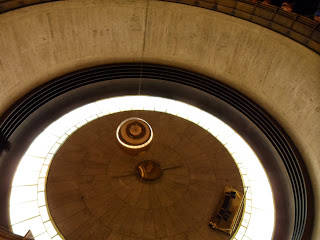On November 9th, I went to the Griffith Observatory with my
friend. With a bit of luck, we were joined by a group of LA Astronomers in
setting up their telescopes for visitors like us to take a look at the moon. For
the first time in my life, I could see what the surface of the moon looks like
and how beautiful it was with my own eyes. There was also a picture indicating what we were looking at (Figure 1). It is through this technology of
telescope can I have the chance to see this piece of artwork (sight of moon)
provided by nature. With the abundance of people and limited telescope, we had to get in lines before taking a look (Figure 2). One of the astronomers was also friendly in giving us a few
of his old magazine to learn more about the moon.
Inside the observatory, the first item we encounter was a
huge pendulum. The pendulum proves that Earth rotate on its axis. Since without Earth rotating on its own axis, the pendulum will continue to move back and forth in the same direction.There were a
line of blocks, after a while, the pendulum will run into the blocks. In the picture below, the blocks has already been knocked over. The second picture provides a detailed description of this concept. (Figure 3, 4)
Next we came upon the descriptions of how the moon rotates, and how do solar and lunar eclipses come to being. It is through these knowledge acquired by technology, can we understand the beauty and reasons behind the eclipses as well as different shapes of the moonlight. The pictures below shows two of the panels indicating the relative position of the moon and the earth during different time of the year and various phases of the eclipses. ( On the background of figure 6, 7 the lecturer is explaining the theory of eclipses.)
Next we came upon the descriptions of how the moon rotates, and how do solar and lunar eclipses come to being. It is through these knowledge acquired by technology, can we understand the beauty and reasons behind the eclipses as well as different shapes of the moonlight. The pictures below shows two of the panels indicating the relative position of the moon and the earth during different time of the year and various phases of the eclipses. ( On the background of figure 6, 7 the lecturer is explaining the theory of eclipses.)
By the end of the visit, my friend and I took a walk on the
upper level of the observatory and enjoyed a great view of the city of Los
Angeles. With the technological advancement of the camera, I can still keep a
hold of the beauty I saw that night.
Overall, the event was very enjoyable and I gained a deeper
understanding of the connection between art and technology. Technologies enable
us to see the moon, understand the eclipses, and capture the beauty of Los
Angeles at night.
1."Eclipse Anular (En Construcción )." Eclipse Anular:Historia De Los Eclipses. N.p., n.d. Web. 24 Nov. 2013. <http://asaaf.fis.ucm.es/eclipseanular/historia-in.htm>.
2. "Official Site: Griffith Observatory Los Angeles, CA." Official Site: Griffith Observatory Los Angeles, CA. N.p., n.d. Web. 24 Nov. 2013. <http://www.griffithobs.org/>.
3. "Digital Lunar Orbiter Photographic Atlas of the Moon." Digital Lunar Orbiter Photographic Atlas of the Moon. N.p., n.d. Web. 24 Nov. 2013. <http://www.lpi.usra.edu/resources/lunar_orbiter/>.
4. "The Moon - Facts About The Moon For Kids." The Moon - Facts About The Moon For Kids. N.p., n.d. Web. 24 Nov. 2013. <http://www.planetsforkids.org/moon-moon.html>.
5. "Eclipse." Eclipse. N.p., n.d. Web. 24 Nov. 2013. <http://eofdreams.com/photo/eclipse/03/>.
2. "Official Site: Griffith Observatory Los Angeles, CA." Official Site: Griffith Observatory Los Angeles, CA. N.p., n.d. Web. 24 Nov. 2013. <http://www.griffithobs.org/>.
3. "Digital Lunar Orbiter Photographic Atlas of the Moon." Digital Lunar Orbiter Photographic Atlas of the Moon. N.p., n.d. Web. 24 Nov. 2013. <http://www.lpi.usra.edu/resources/lunar_orbiter/>.
4. "The Moon - Facts About The Moon For Kids." The Moon - Facts About The Moon For Kids. N.p., n.d. Web. 24 Nov. 2013. <http://www.planetsforkids.org/moon-moon.html>.
5. "Eclipse." Eclipse. N.p., n.d. Web. 24 Nov. 2013. <http://eofdreams.com/photo/eclipse/03/>.








No comments:
Post a Comment